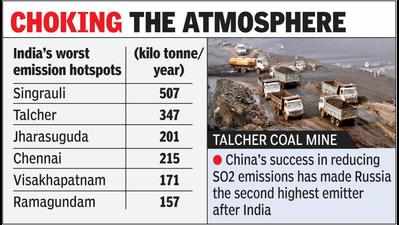- News
- City News
- Hyderabad News
- Ramagundam sixth worst SO2 emitter in India: Report
Trending
This story is from August 20, 2019
Ramagundam sixth worst SO2 emitter in India: Report
Several Indian cities and towns are world’s worst hotspots of sulphur dioxide emission, according to a report released by Greenpeace on Monday. This includes Vishakapatnam, Chennai, Vijayawada and Ramagundam.

Several Indian cities and towns are world’s worst hotspots of sulphur dioxide emission, according to a report released by Greenpeace on Monday. This includes Vishakapatnam, Chennai, Vijayawada and Ramagundam.
HYDERABAD: Several Indian cities and towns are world’s worst hotspots of sulphur dioxide emission, according to a report released by Greenpeace on Monday. This includes Vishakapatnam, Chennai, Vijayawada and Ramagundam.
The Greenpeace report, which was released after analysing data from NASA’s Ozone Monitoring Instrument satellite, revealed that the thermal power plants, or clusters, in Singrauli, Neyveli, Talcher, Jharsuguda, Korba, Kutch, Chennai, Ramagundam, Chandrapur and Koradi are the major emission hotspots in the country.
“India is the largest emitter of SO2, contributing more than 15% of global human-generated SO2 emissions from NASA-detected hotspots,’ the report said.

Coal burning is the biggest reason for Indian emissions. Other causes include extracting metal from ore, and other vehicular pollution. The report also said that apart from there being an increase of SO2 emissions at the already existing hotspots, new sites are emerging, generating more emissions.
Greenpeace senior campaigner Pujari Sen said, “This report makes it clear that we cannot give coal power plants a free hand to continue polluting the country.”
The Supreme Court of India recently moved the deadline for the installation of flue-gas desulfurization (FGD) in power plants from 2017 to 2022.
Retired IFS official Padmanabha Reddy, who has filed several RTIs regarding thermal power plants, told TOI: “While thermal power plants are blamed all over the world for sulphur dioxide pollution, the Telangana government is going on expanding power plants Yadadri and Bhadradri in a big way causing damage to the environment. At Bhadradri, the government is using outdated sub-critical technology.”
The Greenpeace report, which was released after analysing data from NASA’s Ozone Monitoring Instrument satellite, revealed that the thermal power plants, or clusters, in Singrauli, Neyveli, Talcher, Jharsuguda, Korba, Kutch, Chennai, Ramagundam, Chandrapur and Koradi are the major emission hotspots in the country.
“India is the largest emitter of SO2, contributing more than 15% of global human-generated SO2 emissions from NASA-detected hotspots,’ the report said.

According to the data, Vishakapatnam records 171 kilo tonnes per year of sulphur dioxide emission. Ramagundam records 157 kilo tonnes per year, followed by Vijayawada, which has 63 kilo tonnes per year. Chennai has emission records of 215 kilotons per year. Singrauli, in Madhya Pradesh, records the highest SO2 emission in India, at 507 kilo tonnes per year.
Coal burning is the biggest reason for Indian emissions. Other causes include extracting metal from ore, and other vehicular pollution. The report also said that apart from there being an increase of SO2 emissions at the already existing hotspots, new sites are emerging, generating more emissions.
Greenpeace senior campaigner Pujari Sen said, “This report makes it clear that we cannot give coal power plants a free hand to continue polluting the country.”
The Supreme Court of India recently moved the deadline for the installation of flue-gas desulfurization (FGD) in power plants from 2017 to 2022.
Retired IFS official Padmanabha Reddy, who has filed several RTIs regarding thermal power plants, told TOI: “While thermal power plants are blamed all over the world for sulphur dioxide pollution, the Telangana government is going on expanding power plants Yadadri and Bhadradri in a big way causing damage to the environment. At Bhadradri, the government is using outdated sub-critical technology.”
End of Article
FOLLOW US ON SOCIAL MEDIA










